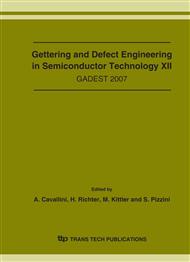p.497
p.503
p.511
p.517
p.523
p.529
p.535
p.541
p.547
On the Failure of Intelligent Power Devices Induced by Extreme Electro-Thermal Fatigue. A Microstructural Analysis
Abstract:
Microstructural analysis of power devices were carried out on components from Freescale Semiconductor that underwent extreme electro-thermal fatigue. Several destructive and non destructive techniques were used. It is shown that the main cause of devices failure is delamination between the heat sink and the power die. Additional causes of failure are identified. The fatigue-induced modifications of the structure of the metallization layer (grain growth, grain boundary grooving) is also discussed.
Info:
Periodical:
Pages:
523-528
Citation:
Online since:
October 2007
Price:
Сopyright:
© 2008 Trans Tech Publications Ltd. All Rights Reserved
Share:
Citation:


